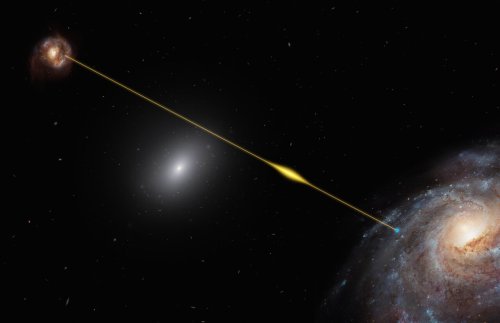
In a galactic version of killing two birds with one stone, astronomers have come up with a way to investigate two different puzzling cosmic phenomena at the same time. Firstly, there are fast radio bursts, which are short and bright radio signals of unknown origin. Secondly, there are galactic halos, which are elusive spherical components of galaxies (as opposed to the flat disks you see in galaxies like our Milky Way).
Using the European Southern Observatory’s Very Large Telescope, astronomers observed a fast radio burst from a distant galaxy which passed through a galactic halo. The burst, called FRB 181112, was barely affected by the halo, which suggests the halo has lower density and a weaker magnetic field than previously thought.
“This galaxy’s halo is surprisingly tranquil,” J. Xavier Prochaska, professor of astronomy and astrophysics at the University of California Santa Cruz and lead author of the research, said in a statement. “The radio signal was largely unperturbed by the galaxy, which is in stark contrast to what previous models predict would have happened to the burst.”
Galactic halos are believed to contain dark matter as well as regular matter, composed mostly of hot ionized gas. The glowing part of a galaxy that we see is only a small part of its total mass, as the halo can be up to ten times larger. “The signal from the fast radio burst exposed the nature of the magnetic field around the galaxy and the structure of the halo gas,” Prochaska said. “The study proves a new and transformative technique for exploring the nature of galaxy halos.”
The radio burst was made up of several fast pulses, each less than 40 microseconds in duration. As the pulses are so fast, we can tell that the halo gas must not be very dense or else if would have changed the radio signal. The calculations show that the halo gas must have a density of less than 0.1 atoms per cubic centimeter. “Like the shimmering air on a hot summer’s day, the tenuous atmosphere in this massive galaxy should warp the signal of the fast radio burst,” coauthor Jean-Pierre Macquart said in the same statement. “Instead we received a pulse so pristine and sharp that there is no signature of this gas at all.”
As interesting as these results are, for now they can only be applied to the one galaxy studied. Whether the same is true of other galactic halos has yet to be determined. “This galaxy may be special,” Prochaska said. “We will need to use fast radio bursts to study tens or hundreds of galaxies over a range of masses and ages to assess the full population.”
The findings are published in the journal Science.
Editors' Recommendations
- Astronomers detect weird ‘heartbeat’ pulse of radio waves
- This tiny exoplanet 35 light-years away is half the mass of Venus
- Scientists spot cyclical pattern in mysterious cosmic radio bursts
- Astronomers search tiny galaxies to understand the evolution of black holes
- See the most detailed view yet of the center of our galaxy